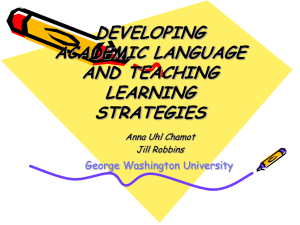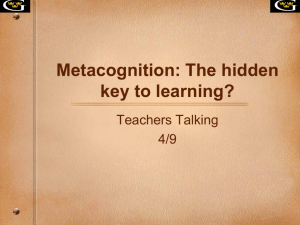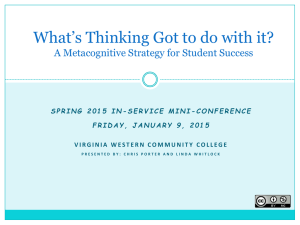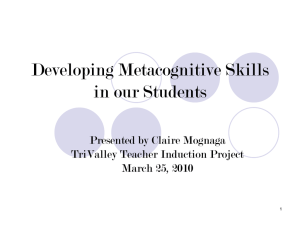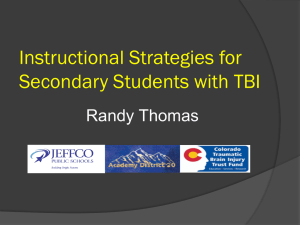THE EFFECTS OF EXPLICITLY TEACHING METACOGNITIVE TECHNIQUES IN By
advertisement
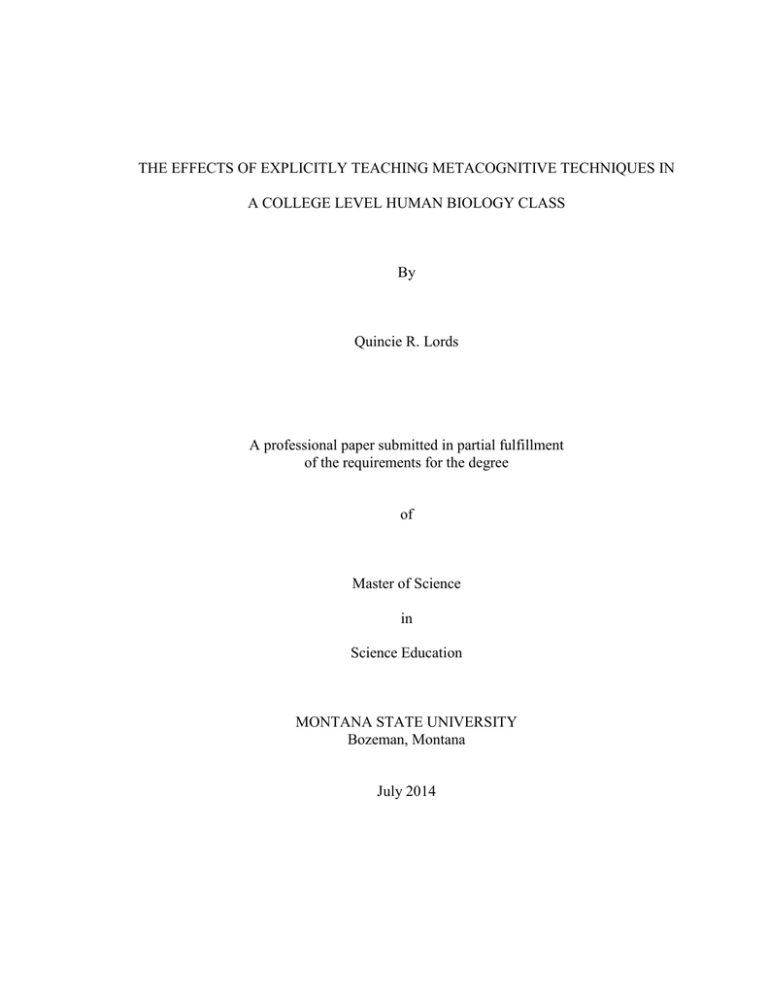
THE EFFECTS OF EXPLICITLY TEACHING METACOGNITIVE TECHNIQUES IN A COLLEGE LEVEL HUMAN BIOLOGY CLASS By Quincie R. Lords A professional paper submitted in partial fulfillment of the requirements for the degree of Master of Science in Science Education MONTANA STATE UNIVERSITY Bozeman, Montana July 2014 ii STATEMENT OF PERMISSION TO USE In presenting this professional paper in partial fulfillment of the requirements for a master’s degree at Montana State University, I agree that the MSSE Program shall make it available to borrowers under rules of the program. Quincie R. Lords July 2014 iii TABLE OF CONTENTS INTRODUCTION AND BACKGROUND ................................................................ 1 CONCEPTUAL FRAMEWORK ................................................................................ 3 METHODOLOGY ...................................................................................................... 5 DATA AND ANALYSIS ............................................................................................ 8 INTERPRETATION AND CONCLUSION ............................................................. 11 VALUE ...................................................................................................................... 12 REFERENCES CITED .............................................................................................. 14 APPENDICES ........................................................................................................... 16 APPENDIX A: Institutional Review Board Approval .................................. 17 APPENDIX B: Student Pre/Post Interview ................................................... 19 APPENDIX C: Learning Style Inventory ...................................................... 21 APPENDIX D: Student Post Test Reflection ............................................... 24 iv LIST OF TABLES 1. Data Triangulation Matrix ...................................................................................... 8 2. Percent Change in Exam Scores for Fall and Spring Semester .............................. 8 v LIST OF FIGURES 1. Average Year Success Rate .................................................................................... 2 2. Concept Card .......................................................................................................... 6 3. Change in Reported Ability from Pre to Post Treatment ...................................... 10 vi ABSTRACT The success rate for Basic Human Biology at Great Falls College – MSU has been declining the last three years. While reflecting on possible reasons for the decline, I narrowed it down to the three most common reasons students seek my help during office hours. These were difficulty with note taking, poor time management and failure to learn from errors. This project evaluated the effect of teaching metacognitive strategies on academic performance, self-efficacy, and ability of students to select appropriate metacognitive strategies. Students were taught time management and study strategies along with reflection activities. Data collection for this project included surveys, interviews, field notes, and exam scores. The results indicated that note taking, study skills and time management improved. Self-efficacy remained the same while academic performance results were inconclusive. The positive outcomes from this project have encouraged me to continue implementing these strategies. 1 INTRODUCTION AND BACKGROUND Great Falls College-Montana State University is a non-residential two-year college located in Great Falls, Montana. The enrollment for 2011-2012 was 2,527 with a full time equivalency of 1,441 students. Full-time students comprised 52% of the student population while part-time students made up the remaining 48%. Average age of students in the school was 28, 45.4% were 18-24 years old and 52% were 25 years of age or older. Female students accounted for 71% of the population and males students 29%. Financial aid was received by 71% of our students (MSU-Great Falls, 2012). Eighty-two percent of the students in my class were taking Basic Human Biology to help prepare for Anatomy and Physiology I. This group of 29 students was predominately white, with females comprising 83% and males 17%. Seventy-three percent of the students were returning to college to pursue a second career or make a second attempt at higher education after withdrawing previously for various reasons. The average age of the students was 28 years old, and all were pursuing health science careers. Basic Human Biology is strongly recommended prior to taking Anatomy and Physiology I. This group of students was split into two sections with twenty-one students in each section. Students had lecture class twice a week for seventy-five minutes and lab once a week for one hour and fifty minutes. Over the last four semesters there has been a decrease in the number of students successfully completing Basic Human Biology with a grade of “C” or better. This trend was in all sections of Basic Human Biology. In 2009 the success rate was 69.8%, while in 2 2010 it was 61.3 % and in 2011 it was 51.7% (Figure 1). Figure 1. Average Year Success Rate. Personal classroom observations and discussions with other instructors revealed that students were struggling with how to study, read their textbook and manage time. I decided to attempt to teach these skills within my basic human biology course. The purpose of this study was to evaluate the effectiveness of explicitly teaching metacognitive strategies to students in a college level human biology course. The following questions were explored. 1. What effect did teaching metacognitive strategies to students have on academic performance? 2. What effect did teaching metacognitive strategies to students have on selfefficacy? 3. What effect did teaching metacognitive strategies to students have on their ability to select the appropriate strategies? 3 CONCEPTUAL FRAMEWORK Students are exposed to a large amount of information in their courses. How they manage and recall this information can greatly influence their academic success (Pintrich, 2002; Burchard & Swerdzewski, 2009). In general metacognition is the process of thinking about one’s own thoughts (Flavell, 1979). A student’s awareness of their own thoughts regarding how they learn and reason is an example of metacognition. Successful students are aware of more metacognitive strategies and tactics than their cohorts (Dunlosky & Metcalfe, 2009; Lee, Lim & Grabowski, 2010). The definition of metacognition within the context of education varies widely in the literature (Dulonsky & Metcalfe, 2009; Schraw, et. al, 2006; Kaplan, 2008; Dinsmore, Alexander & Loughlin, 2008). Each of these variations provides a useful perspective on student learning. Acccording to Dulonsky and Metcalfe (2009), metacognition incorporates the processes of knowledge, monitoring and controlling. Understanding how the brain processes information is an example of metacognitive knowledge. For example, students monitor their learning when they judge how well they have learned a topic and exercise control when they decide to use a different problem solving technique. Schraw, Crippen and Hartley (2006) have a slightly different description of metagcognition. They explain metacognition as “skills that enable learners to understand and monitor their cognitive processes” (p. 112). Within their description of metacognition, they subdivide it into two processes, knowledge and regulation of cognition. Knowledge of cognition includes knowledge about ourselves as students, knowledge about strategies, and knowledge of when and why to use a strategy. 4 Regulation of cognition includes planning, such as time management, monitoring, such as self-testing, and evaluating, such as re-evaluating goals. Multiple metacognitive strategies have been researched regarding their use and effectiveness. Marzano, Pikcering and Polluck (2005) provide a detailed explanation of research-based strategies for increasing student achievement. Generating and testing hypotheses, summarizing and note taking, nonlinguistic representations and identifying similarities and differences are some of the metacognitive strategies they describe. Schraw et al., (2006) suggest strategies such as modeling, cooperative learning, making mental models and using electronic assessment systems to provide immediate feedback. Mintzes, Wandersee and Novak (2001) suggest strategies including concept maps, Vdiagrams, clinical interviews, writing, and performance measures. There are many ways that metacognitive strategies can be used. However, students do not seem to develop these strategies unless they are explicitly taught them (Kiewara, 2002; Pintrich 2004). A study by Rachal, Daigle and Rachal (2007) found that freshman and senior college students self-reported just as many learning difficulties, rather than less. It has been noted that strategy instruction is rarely part of the curriculum (Kiewra, 2002; Rachal, Daigle & Rachal, 2007; Burchard & Swerdzewski, 2009). Strategy instruction was emphasized by Cornford (1999 & 2002) as an effective educational practice to improve what he called “learning-to-learn strategies.” According to Cornford, these strategies are important to compete in the ever-changing work-force (1999 & 2002). Other educators have embraced this as well (Pintrich, 2002; Kiewra, 2002; Burchard & Swerdzewski, 2009). A mandatory cognitive skills course was implemented by a medical school to help at-risk students who failed their first semester 5 with both content and learning-processes (Winston, Van Der Vleuten & Scherpbier, 2010). Of the students who participated, 91% passed their repeat semester, compared to 58% who did not take the cognitive skills course. Instructors can use multiple methods to teach students metacognition. The diversity of strategies enables an instructor to provide an individualized skill set to each student. With time and practice, students are better able to adapt to various learning environments. METHODOLOGY The research methodology for this project received an exemption by Montana State University’s Institutional Review Board and compliance for working with human subjects was maintained (Appendix A). Students were taught specific metacognitive strategies to help improve the greatest area of need as self-reported in the Student Pre Interview (Appendix B) and based upon results from the Learning Style Inventory (Appendix C). Students were taught when to use specific strategies, why to use the strategies and how to adapt the strategies to their needs. The skills taught included notetaking, time management strategies, and study strategies. During the first unit, Organization of the Body, students were not taught any metacognitive strategies. They were asked to voluntarily participate in Post Test Reflections (Appendix D). In the next two units, Covering, Support, and Movement of the Body, Parts I & II, students were taught note taking skills, how to make concepts, and create tables to organize information. The concept card is a type of flashcard for vocabulary or concepts. The front of the card has the word used in a sentence and a location where the word can be found. The back of the card has the definition and a 6 diagram or illustration representing the word (Figure 3). Figure 2. Concept Card Students used the cards to develop a foundational knowledge and then in class worked on relating the concepts to each other or to body systems. In addition to the strategy, students were asked to continue to voluntarily participate in post-exam reflections. During the fourth unit, Regulation and Integration of the Body, students were not taught additional strategies. The data collection began at the end of the semester in fall of 2012. Exam scores were gathered for use as comparison to the spring 2013 exam scores. The data collection instruments included the Student Pre/Post Interviews (Appendix B), the Learning Style Inventory (Appendix C), the Student Post Test Reflections (Appendix D), and comprehensive unit tests (Table 1). The Student Pre/Post Interview was used to help determine the students’ familiarity with metacognitive skills such as note taking and time management (Appendix A). Other questions within the survey focused on self-efficacy and knowledge of student learning style(s). Student volunteers were used to participate in the interview. The interviews took place during office hours and after class. Students were asked to answer the questions as they pertained to their basic human biology class. 7 Students were asked to elaborate when answering questions if needed. Notes were taken and interviews were recorded electronically, when possible, to keep accurate records. The Learning Style Inventory was used to help determine the various ways each student prefers to acquire and learn content (Appendix C). The results were used to group the students by learning style. Once grouped, they were taught one study strategy relevant to their style of learning during the second and third units. The visual learner’s were taught how to create flow charts and tables using colors and shapes to group concepts. The auditory learners were tasked with reading out loud to themselves and listening to audio recordings of the class. Kinesthetic learners were encouraged to build models and to move around when they study. Grouping students by learning style also provided opportunities for them to share and compare effective individual learning strategies. Data from the Pre and Post Student Interview along with teacher observation and reflection were compared in order to determine the effects of teaching students metacognitive skills on self-efficacy and ability to select appropriate learning strategies. The Student Post Interview was used to determine if their self-efficacy, attitudes, and knowledge of their learning style(s) and metacognitive strategies had changed (Appendix B). The post-interview questions were the same as the pre-interview questions. The Student Post Test Reflection was used to determine their ability to adapt metacognitive strategies (Appendix D). The comprehensive test scores from fall and spring semester were used to measure academic performance before and after treatment. I kept field notes to record student observations and personal reflections. 8 Table 1 Data Triangulation Matrix Focus Questions Data Source 1 Primary Question: What effect did teaching Pre and post metacognitive strategies treatment exam have on student scores performance? Secondary Questions: What effect did teaching Student pre metacognitive strategies interview have on student selfefficacy? What effect did teaching metacognitive strategies Student pre have on students’ ability interview to select appropriate strategies? Data Source 2 Data Source 3 Student post interview Teacher field notes Student post interview Student post test reflection Student post interview Teacher field notes DATA AND ANALYSIS The comparison of exam scores between the fall semester and spring semester allowed for examination of percent changes in scores between the non-treatment group, with 39 students, and treatment group with 29 students (Table 2). The results of the unit exams show better comprehension by the treatment group. The positive changes for the treatment group were +0.51% for the first exam, +0.79% for the second, and +0.54% on the third. The overall average on the cumulative final shows better comprehension by the non-treatment group with a 74.27%, while treatment group average was 73.00%. Table 2 Percent Change in Exam Scores for Fall and Spring Semester Semester Exam 1 Exam 2 Exam 3 Fall 2012 (N=39) 72.31% 67.88% 70.73% (Nontreatment Group) Spring 2013 (N=29) 72.82% 68.67% 71.27% (Treatment Group) Percent Change from +0.51% +0.79% +0.54% fall to spring Final Exam 74.27% 73.00% -1.27% 9 At the beginning of the semester 96.5% of the students believed they were a good student, while 100% students believed they were capable of success. By the end of the semester 100% of the students reported they believed they were good students. One student commented, “I decided to go to college because I believe I am capable of success.” The Student Pre Interview indicated that 51.7% of the students knew their learning style. The Post Student Interview indicated that 93% of the students knew their learning style. One student commented that “I like to be able to see the concepts. I prefer visual aids for learning.” The Learning Style Inventory indicated that 61% of students were visual, while 29% were auditory and 10% were kinesthetic. None of the students’ inventory results indicated multiple learning styles. In the Student Pre Interview, 41% of students reported they knew how to take notes, 52% reported they knew how to study and 41% reported they knew time management strategies. In the post interview 69% of the students reported they knew how to take notes, 62% reported they knew how to study and 72% reported they knew time management strategies (Figure 1). One student commented that they “knew time management strategies before, but now I use them.” 10 Figure 3. Change in Reported Ability from Pre to Post Treatment, (N=29). As the semester progressed students were using their planners more often to write down important information and dates. There were five student comments in the discussion area available online during the first unit and they related to due dates for assignments. During the second unit, thirty comments were made and forty comments during the third. This area was made available to students to use in addition to our face to face lecture, lab and review times. During units two through four, students used this area to ask questions about content and study strategies as well as to create study groups. Students reported an 18% increase when asked about reading their book regularly and a 10% increase in comprehension of material read. The Student Post Test Reflection was used after the first three unit exams. The majority of students, over 85%, on each exam ranked their performance as fair or good. When asked what one or two things they thought were most helpful in preparing for the first exam, one student commented, “I’m not sure what helped.” Another student, when asked the same question after the second exam, commented, “Creating mind-maps and 11 color coding tables really helped.” When asked if there was anything they would do differently to prepare for the second exam, one student commented,” Read the book and attend the review sessions.” Another student, after the second exam said “Make more tables to help organize information.” INTERPRETATION AND CONCLUSION Overall I believe that teaching students metacognitive skills, such as time management and post test reflection, improved student success in all areas. According to the data, the students reported an increase in their metacognitive abilities. Like the Pre/Post Student Interviews, student written responses on the reflections, indicated an improved understanding of which learning strategies to use. I was very surprised by the high level of self-efficacy reported in the Pre Student Interview when asked about their ability to be successful and if they were a good student. The students sitting in class with me at the beginning of the semester did not seem confident. They barely made eye contact or asked questions. By the end of the semester their presence and participation had greatly increased and improved. I observed, and the students reported, that their ability to take notes, manage time and study were low. I was surprised to find that it didn’t take much time away from the content to teach these skills. Students were appreciative and their skills improved. This led to them being better prepared for class and using their time more effectively. An overall increase in academic performance was expected for the treatment group compared to the non-treatment group. Yet he difference between the final exam and lecture exams between the two groups was inconclusive. This could have been due to differences in the overall class demographics, the times the classes were held, or even 12 how I taught the material. There are many variables that could have affected the results. I will continue to research this area of possible academic improvement. I may include test corrections to have students reflect on why they got the question wrong and how they can prevent themselves from getting it wrong again. VALUE The students gained a great set of skills, such as note taking, study strategies, and time management strategies to choose from and integrate into their academic and professional careers. I gained a better appreciation for taking the time to teach study skills, specifically concept cards, because it led to a better classroom experience for both the students and me. This is an area that I will continue to research and to implement because it’s what I believe is best for the students. The research process provided an opportunity for me to analyze what was taking place in my class. I have a better appreciation for the value of both qualitative and quantitative data. The students’ feedback was the most valuable information for me. It provided me with confirmation of what I was observing. I will continue to use surveys and interviews with my students because I believe they are the best indicator of how we as teachers can change and grow. Colleagues were intrigued by what I was doing in class. This created some helpful talking points in our department about what we are doing and why we are doing it. This was a great experience. It has changed the way I teach by helping me to focus more on the why than the what. I have found that analyzing why students should know or do something helps me to better explain and emphasis specific points. Instead of every objective being of equal importance, I am able help students see the “forest” then I can 13 bring greater attention to some “trees” over others. As a teacher, I changed from being the leader to being their teammate. I have really focused on developing their skills as students. When they were better prepared as students they were able to do more application based learning activities such as case studies. They took more initiative to facilitate their own learning and knew I was there if they needed me. Overall the experience was one which provided opportunities for growth personally and professionally. Personally I feel as sense of accomplishment. Professionally, my ability as a teacher to analyze the classroom, my students, and possible solutions has increased greatly. I am much more confident in my abilities as an instructor to provide what my students need. 14 REFERENCES CITED Burchard, M.S., & Swerdzewski, P. (2009). Learning effectiveness of a strategic learning course. Journal of College Reading and Learning, 40, 14-34. Cornford, I.R. (1999). Imperatives in teaching for lifelong learning: moving beyond rhetoric to effective educational practice. Asia-Pacific Journal of Teacher Education, 27, 107-117. Cornford, I.R. (2002). Learning-to-learn strategies as a basis for effective lifelong learning. International Journal of Lifelong Education, 21, 357-368. Dinsmore, D.L., Alexander, P.A., & Loughlin, S.A. (2008). Focusing the conceptual lens on metacognition, self-regulation, and self-regulated learning. Educational Psychology Review, 20, 391-409. Dunlosky, J., & Metcalfe, J. (2009). Metacognition. Los Angeles: SAGE. Flavell, J. H. (1979). Metacognition and cognitive monitoring: A new area of congnitivedevelopmental inquiry. American Psychologist, 34, 906-911. Kaplan, A. (2008). Clarifying metacognition, self-regulation, and self-regulated learning: What’s the purpose? Educational Psychology Review, 20, 477-484. Kiewra, K.A. (2002). How classroom teachers can help students learn and teach them how to learn. Theory Into Practice, 41, 71-80. Lajoie, S.P. (2008). Metacognition, self regulation, and self-regulated learning: A rose by any other name? Educational Psychology Review, 20, 469-475. Lee, H.W., Lim, K.Y., & Grabowski, B.L. (2010). Improving self-regulation, learning strategy use, and achievement with metacognitive feedback. Education Technology, Research and Development, 58, 629-648. Marzano, R.J., Pickering, D.J., & Polluck, J.E. (2005). Classroom instruction that works: Research-based strategies for increasing student achievement. Columbus: Pearson-Merill Prentice Hall. Mintzes, J.L., Wandersee, J.H., & Novak, J.D. (2001). Assessing understanding in biology. Journal of Biological Education, 35, 118-124. MSU-Great Falls College of Technology Fact Book 2011-2012, (2012). 15 Pintrich, P.R., (2002). The role of metacognitive knowledge in learning, teaching and assessing. Theory Into Practice, 41, 219-225. Pintrich, P.R., (2004). A conceptual framework for assessing motivation and selfregulated learning in college students. Educational Psychology Review, 16, 385407. Rachal, K.C., Daigle, S., & Rachal, W.S. (2007). Learning problems reported by college students: Are they using learning strategies. Journal of Instructional Psychology, 34, 191-199. Sandi-Urena, A., Cooper, M.M., & Stevens, R.H. (2011). Enhancement of metacognition use and awareness by means of a collaborative intervention. International Journal of Science Education, 33, 323-340. Schraw, G., Crippen, K.J., & Hartley, K. (2006). Promoting self-regulation in science education: Metacognition as part of a broader perspective on learning. Research in Science Education, 36, 111-139. Thomas. G., Anderson, D. & Nashon, S. (2008). Development of an instrument designed to investigate elements of science students’ metacognition, self-efficacy and learning processes: The SMELI-S. International Journal of Science Education, 30, 1701-1724. Winston, K.A., Van Der Vleuten, C.P.M., & Scherpbier, A.J.J. (2010). An investigation into the design and effectiveness of a mandatory cognitive skills programme for at-risk medical students. Medical Teacher, 32, 236-243. 16 APPENDICES 17 APPENDIX A INSTITUIONAL REVIEW BOARD APPROVAL 18 19 APPENDIX B STUDENT PRE/POST INTERVIEW 20 Student Pre/Post Interview Participation in this interview is voluntary and participation or non-participation will not affect your grade or class standing. 1. Do you know how to take notes? a. If yes, how do you take notes? b. If no, have you ever been taught how to take notes? 2. Do you know how to study to perform well on tests? a. If yes, how do you study? 3. Do know how to schedule your time to accomplish your tasks? a. If yes, how do you manage your time? b. If no, have you ever been taught how to manage your time? 4. Do you read your textbook regularly? a. If no, why not? 5. Do you understand the material you read in your textbook? a. If yes, how do you know you understand the material? b. If no, how do you know that you don’t understand the material? 6. Do you find your college courses interesting and absorbing? 7. Do you believe you are capable of succeeding? 8. Do you believe you are a good student? 9. Do you know your learning style(s)? a. If yes, what (is it/are they)? b. If yes, how did you discover (it/them)? c. If no, what type of instruction do you prefer? (give examples if necessary) 10. Is there anything you would like to add? 21 APPENDIX C LEARNING STYLE INVENTORY 22 Learning Style Inventory Participation in this learning style inventory is voluntary and participation or non-participation will not affect your grade or class standing. For these questions, choose the first answer that comes to mind and then write a, b, or c on the line. Don’t spend too much time thinking about any one question; go with your initial impulse. ____ 1. When you study for a test, would you rather a. Read notes, read headings in a book, and look at diagrams and illustrations b. Have someone ask you questions, or repeat facts silently to yourself c. Write things out on index cards and make models or diagrams ____ 2. Which of these do you do when you listen to music? a. Daydream (see things that go with the music) b. Hum along c. Move with the music, tap your foot, etc. ____ 3. When you work at solving a problem, do you a. Make a list, organize the steps, and check them off as they are done b. Make a few phone calls and talk to friends or experts c. Make a model of the problem or walk through all the steps in your mind ____ 4. When you read for fun, do you prefer a. A travel book with a lot of pictures in it b. A mystery book with a lot of conversation in it c. A book where you answer questions and solve problems ____ 5. To learn how a computer works, would you rather a. Watch a movie about it b. Listen to someone explain it c. Take the computer apart and try to figure it out yourself ____ 6. You have just entered a science museum, what will you do first? a. Look around and find a map showing the locations of various exhibits b. Talk to a museum guide and ask about the exhibits c. Go into the first exhibit that looks interesting, and read directions later ____ 7. What kind of restaurant would you rather not go to? a. One with the lights too bright b. One with the music too loud c. One with uncomfortable chairs 23 ____ 8. Would you rather go to a. An art class b. A music class c. An exercise class ____ 9. Which are you most likely to do when you are happy? a. Grin b. Shout with joy c. Jump for joy ____ 10. If you were at a party, what would you be most likely to remember the next day? a. The faces of the people there, not the names b. The names but not the faces c. The things you did and said while you were there ____ 11. When you see the word “d-o-g”, what do you do first? a. Think of a picture of a particular dog b. Say the word “dog” to yourself quietly c. Sense the feeling of being with a dog (petting it, running with it, etc.) ____ 12. When you tell a story, would you rather a. Write it b. Tell it out loud c. Act it out ____ 13. What is the most distracting for you when you are trying to concentrate? a. Visual distractions b. Noises c. Other sensations like hunger, tight shoes, or worry ____ 14. What are you most likely to do when you are angry? a. Scowl b. Shout or “blow up” c. Stomp off and slam doors ____ 15. When you aren’t sure how to spell a word, which of these are you most likely to do? a. Write it out to see if it looks right b. Sound it out c. Write it out to see if it feels right ____ 16. Which are you most likely to do when standing in a long line at the movies? a. Look at the posters advertising the movies b. Talk to the person next to you. c. Tap your foot or move around in some other way 24 APPENDIX D STUDENT POST TEST REFLECTION 25 Student Post Test Reflection Participation in this reflection is voluntary and participation or non-participation will not affect your grade or class standing. 1. Which of the following best describes how you think you performed on this exam? (Circle One) a. Excellent (90-100%) b. Good (80-89%) c. Fair (70-79%) d. Poor (69% or below) 2. Do you think the time you spent preparing for this exam was: (Circle One) a. Adequate – I’m happy b. Barely enough – I hope I passed c. Not nearly enough – I’m scared to get this one back d. Too much – the test was too easy 3. What one or two things do you think were most helpful to you in preparing for this exam? 4. Now that you have taken this basic human biology exam, is there anything that you will do differently to prepare for the next exam?

